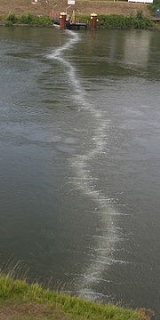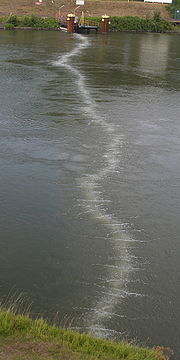
Pneumatic barrier
Encyclopedia

Oil spill
An oil spill is the release of a liquid petroleum hydrocarbon into the environment, especially marine areas, due to human activity, and is a form of pollution. The term is mostly used to describe marine oil spills, where oil is released into the ocean or coastal waters...
s. Air bubbling through a perforated pipe causes an upward water flow that slows the spread of oil. It can also be used to stop fish
Fish
Fish are a paraphyletic group of organisms that consist of all gill-bearing aquatic vertebrate animals that lack limbs with digits. Included in this definition are the living hagfish, lampreys, and cartilaginous and bony fish, as well as various extinct related groups...
from entering polluted water
Water pollution
Water pollution is the contamination of water bodies . Water pollution occurs when pollutants are discharged directly or indirectly into water bodies without adequate treatment to remove harmful compounds....
. Pneumatic barriers are also known as air curtains.
A pneumatic barrier is an active (as opposed to passive) method of waterway oil spill control. (An example of a passive method would be a containment boom
Boom (containment)
A containment boom is a "temporary floating barrier used to contain an oil spill. Booms are used to reduce the possibility of polluting shorelines and other resources, and to help make recovery easier. Booms help to concentrate oil in thicker surface layers so that skimmers, vacuums, or other...
.)
Method of operation
The pneumatic barrier consists of perforated pipe and a compressed air source. Air escaping from the pipe provides a "hump" of rising water and air which contains the oil spill. Anchors keeping the pipe in a decided spot are helpful.Unique considerations
At water current speeds exceeding one foot per second, the pneumatic barrier no longer functions effectively, limiting deployable sites.Environmental issues
The release of compressed air in the water adds oxygen to the local environment. This may be particularly useful in an area which has become a dead zoneDead zone (ecology)
Dead zones are hypoxic areas in the world's oceans, the observed incidences of which have been increasing since oceanographers began noting them in the 1970s. These occur near inhabited coastlines, where aquatic life is most concentrated...
due to eutrophication
Eutrophication
Eutrophication or more precisely hypertrophication, is the movement of a body of water′s trophic status in the direction of increasing plant biomass, by the addition of artificial or natural substances, such as nitrates and phosphates, through fertilizers or sewage, to an aquatic system...
.

